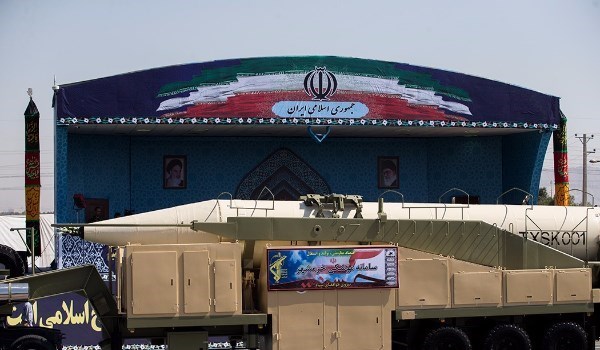
RNA - Per usual, different classes of state-of-the-art missiles were put on display – the ones the Trump White House wants Iran to scrap. Tehran has not only ruled out the possibility of any negotiation on this matter, it even unveiled a new ballistic missile, called Khorramshahr, with the range of 2,000 km, capable of carrying several warheads.
What’s more, addressing the annual event, President Hassan Rouhani vowed that Iran would boost its ballistic missile capabilities despite criticism from the United States. He said, “We are going to strengthen our military capabilities which are necessary for deterrence. We will strengthen not only our missiles but also our air, land and sea forces. When it comes to defending our country, we will ask nobody for their permission.”
President Rouhani also ruled out any change of foreign policy in the region. He said Iran’s defense power has never been used for aggressive acts, while certain countries export deadly weapons to the Middle East, adding, “We are going to defend the oppressed nations of Yemen, Palestine and Syria. Iran has always pursued peace and security in the region and the world. Iran has always defended the oppressed people of the world.”
The grand parade also showcased hundreds of new armaments, including S-300 missiles, short, medium and long range missiles, bombs, tanks, as well as the latest electronic warfare equipment that can disrupt enemy radar and communication in air and field battles. For those who can still remember, some of the missiles paraded on Friday were the ones used by the Islamic Revolution Guards Corps to target ISIL centers in Syria's Deir Ezzur in retaliation for the June 7 twin terrorist attacks in Tehran.
A number of mid-range ground-to-ground missiles fired from the IRGC Aerospace Force bases in Kermanshah and Kurdistan provinces targeted the Takfiri terrorists in this operation and struck them with lethal and crushing blows. A large number of Takfiri terrorists were killed and their equipment, systems and weapons have been destroyed in the operation.
Once again, the attacks brought new attention to Iran’s development of conventional missiles, but paranoid US officials were unable to voice concerns or use it as a justification for further illegal sanctions. That Iran’s only use of these missiles in the past several decades was against ISIL, and the previous use was in defending the country from an Iraqi invasion, reflects that Iran’s missile program has indeed been largely defensive in nature and above-board.
For all the news coverage, Iran also plans to send its new domestically-made satellites into orbit, demonstrating yet again that when it comes to its National Space Program the sky is no longer the limit. Despite the baseless claims and the dominant narrative in Washington, Iran is not using its missile program as a cover to develop long-range ballistic missile technology. It had that technology long before the missile strikes into Syria. Under International Law, nothing prevents Iran from developing long-range ballistic missiles capable of hitting terrorists or delivering satellites.
As maintained by President Rouhani, the defensive nature of Iran’s military capabilities points to the fact that it does not seek military roles beyond its means. The country simply pursues military deterrence against terrorists, which are located within the striking distance of its various missiles - as well as against those paranoid powers with military bases in the Persian Gulf.
Last but not the least, and again as maintained by President Rouhani and Commander of the Islamic Revolution Guards Corps’ Aerospace Force, Brig. Gen. Amir Ali Hajizadeh, the missile program is non-negotiable. The Trump White House’s insistence that ballistic missiles should become a subject of new negotiations - just like the nuclear deal - is a testimony to the country’s superb capabilities in that sphere.
Much to the chagrin of President Trump and company, Iran is one of the 24 founding members of the United Nations Committee on the Peaceful Uses of Outer Space. Under the UN mandate, and just like its missile program, Iran is entitled to master the technology of launching satellites into orbit. Trump’s concerns are not going to stop Iran’s upward mobility into field battles and outer space. Any doubters should ask those who designed, built and unveiled the new ballistic missile, called Khorramshahr, on Friday.
847/940